1.2 Roots, Schools, and Perspectives of Psychology
The field of psychology is almost 140 years old, very young compared to other scientific disciplines, but its core questions are as old as humanity itself. Look at the works of the ancient Greeks, and you will see that they asked some of the same questions as modern psychologists—
Philosophy and Physiology
LO 3 Identify influential people in the formation of psychology as a discipline.

Would you believe that these trees belong to the same species? Both are Jeffrey pines (Pinus jeffreyi), but they have been exposed to dramatically different environmental pressures. Jeffrey pines typically reach 80 to 130 feet. The tree on the left appears to be growing in fertile soil in a thriving forest, whereas the one on the right has virtually sprung from a slab of rock on an 8,122-
The roots of psychology lie in disciplines as diverse as philosophy and physiology. In ancient Greece, the great philosopher Plato (427–

One of Plato’s most renowned students, Aristotle (384 –322 BCE), eventually went on to challenge his mentor’s basic teachings. Aristotle believed that we know reality through our perceptions, and we learn through our sensory experiences, an approach now commonly referred to as empiricism. Aristotle has been credited with laying the foundation for a scientific approach to answering questions, including those pertaining to psychological concepts such as emotion, sensation, and perception (Slife, 1990; Thorne & Henley, 2005). Ultimately, because he believed knowledge is the result of our experiences, Aristotle paved the way for scientists to study the world through their observations.
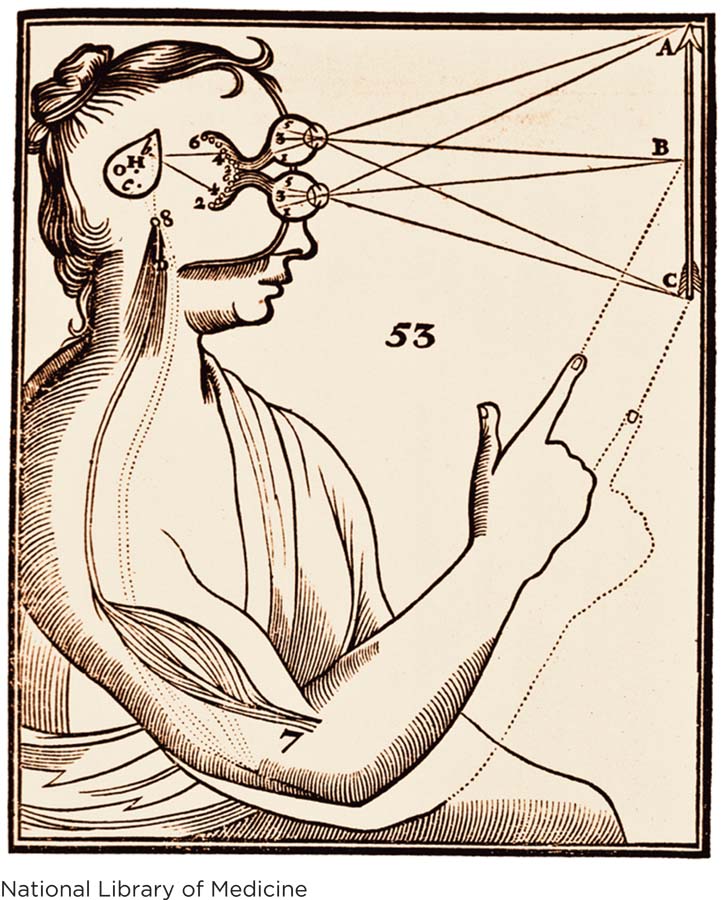
French philosopher René Descartes proposed that the eye and other body parts work like machines. The mind, he suggested, is separate and intangible. But as you will discover in this textbook, many activities of the mind have been traced back to physical interactions among nerve cells.
This notion that experience, or nurture, plays an all-
If Aristotle placed great confidence in human perception, French philosopher René Descartes (dā-’kärt; 1596–
About 200 years later, another scientist experienced a “flash of insight” about the mind–
Psychology Is Born
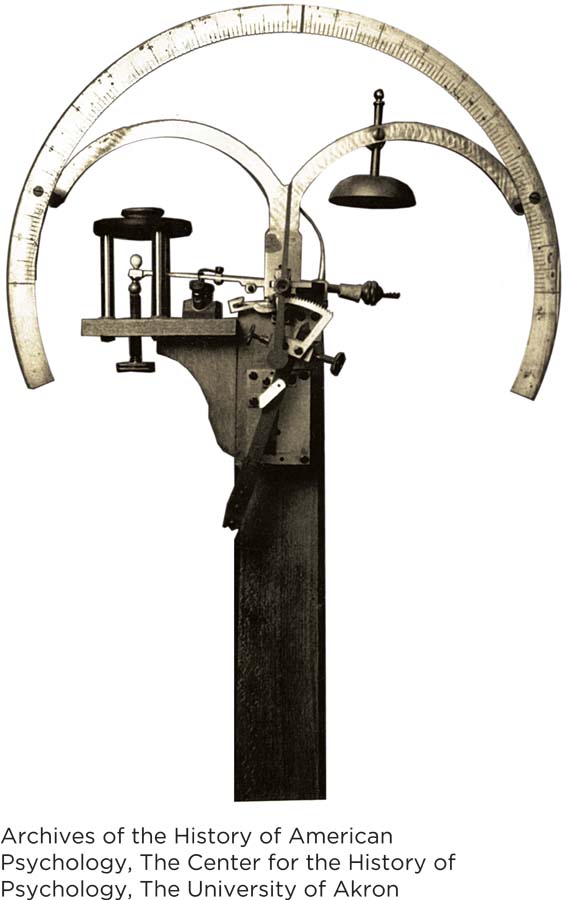
In 1861 Wilhelm Wundt conducted an experiment on reaction time, which was a turning point in the field of psychology. Using a pendulum that hit a bell upon reaching its outer limits, Wundt demonstrated a 10th of a second delay between hearing the bell and noting the position of the pendulum (and vice versa), and it was during that very brief period that a mental process occurred. Finally, activities of the mind could be measured (Thorne & Henley, 2005).
Thus far, the only people in our presentation of psychology’s history have been philosophers and a physicist. You might ask where all the psychologists were during the time of Descartes and Fechner. The answer is simple: There were no psychologists until 1879. That was the year Wilhelm Wundt (vĬl ′hĕlm vŏŏnt) (1832–
introspection The examination of one’s own conscious activities.
The overall aim of Wundt’s early experiments was to measure psychological processes through introspection, a method used to examine one’s own conscious activities. For Wundt, introspection involved effortful reflection on the sensations, feelings, and images experienced in response to a stimulus, followed by reports that were objective, meaning free of opinions, beliefs, expectations, and values. In order to ensure reliable data, Wundt required all his participants to complete 10,000 “introspective observations” prior to starting data collection. His participants were asked to make quantitative judgments about physical stimuli—
structuralism An early school of psychology that used introspection to determine the structure and most basic elements of the mind.
The next time your cell phone vibrates, take the opportunity to engage in some introspection. Grab the cell phone and hold it in your hands (try to resist answering the call). Pay attention to what you experience as you wait for the vibrations to stop. Then put down the phone and consider your experience. Report on your sensations (the color, the shape, the texture, and so on) and feelings (anxiety, excitement, frustration), but make your observations objective.
try this
STRUCTURALISM A student of Wundt’s, Edward Titchener (tĬch′ǝnǝr) (1867–
functionalism An early school of psychology that focused on the function of thought processes, feelings, and behaviors and how they help us adapt to the environment.
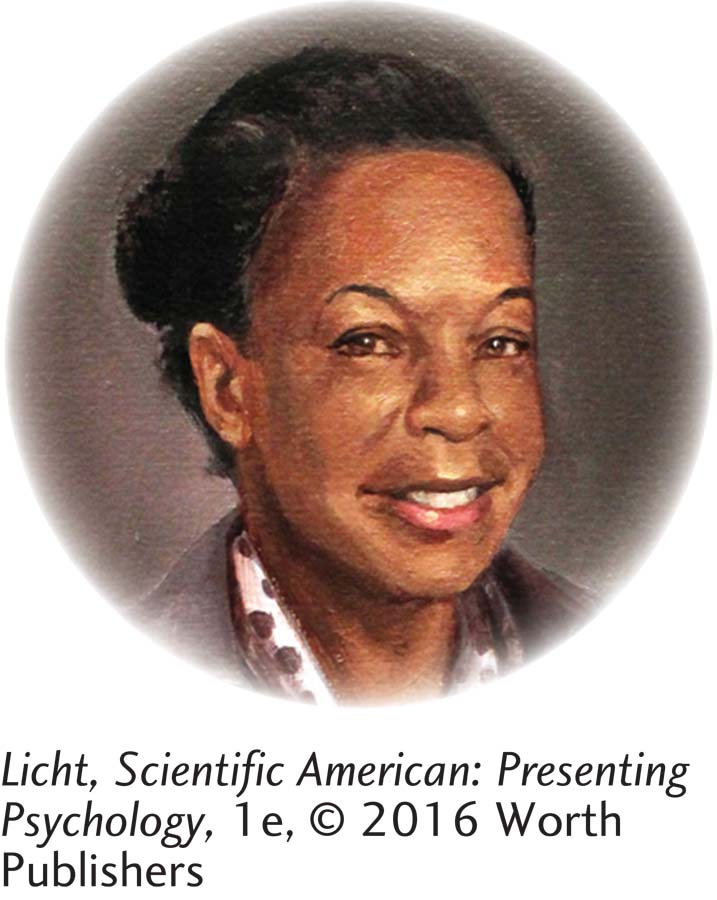
The work of Mamie Phipps Clark raised awareness about the unique psychological issues affecting African American and other minority children. She and her husband founded Harlem’s Northside Center for Child Development, an organization that continues to provide psychological and educational support to children in the community.

Margaret Floy Washburn is perhaps most famous for becoming the first woman psychologist to earn a PhD, but her scholarly contributions must not be underestimated. Her book The Animal Mind: A Textbook of Comparative Psychology (1908), which drew on her extensive research with animals, had an enduring impact on the field (APA, 2013b; Washburn, 2010).
FUNCTIONALISM In the late 1870s, William James (1842–
HERE COME THE WOMEN Like most sciences, psychology began as a “boys’ club,” with men earning the degrees, teaching the classes, and running the labs. There were, however, a few women, as competent and inquiring as their male counterparts, who beat down the club doors long before women were formally invited. One of William James’ students, Mary Whiton Calkins (1863–
Mamie Phipps Clark (1917–
Thanks to trailblazers such as Calkins, Washburn, and Clark, the field of psychology is no longer dominated by men. In fact, about three quarters of students earning master’s degrees and PhDs in psychology are women, a statistic that now has some experts worrying about the need for more men in various subfields (Cynkar, 2007; Willyard, 2011).
Psychology’s Perspectives
LO 4 List and summarize the major perspectives in psychology.
Some of the early schools of psychology had a lasting impact and others seemed to fade. Nevertheless, they all contributed to the growth of the young science. Some of the early schools developed into perspectives that continue to help us understand the complex nature of human behavior. The descriptions below and Infographic 1.1, below show how the early roots of psychology and the perspectives fused and flow together.

Psychology’s most famous icon boards his first airplane in 1928, years after psychoanalysis had gotten off the ground in Europe and America. Freudian ideas are still alive and well, though people often overestimate their importance in psychology. About 90% of American Psychological Association members do not practice psychoanalysis, and most science-
PSYCHOANALYTIC Toward the end of the 19th century, while many early psychologists were busy investigating the “normal” functioning of the mind (in experimental psychology), Sigmund Freud (1856–
behaviorism The scientific study of observable behavior.
BEHAVIORAL As Freud worked on his new theories of the unconscious mind, Ivan Pavlov (1849–
Carrying on the behaviorist approach to psychology, B. F. Skinner (1904 –1990) studied the relationship between behaviors and their consequences. Skinner’s research focused on operant conditioning, a type of learning that occurs when behaviors are rewarded or punished (Chapter 5). Skinner acknowledged that mental processes such as memory and emotion might exist, but they are not topics to be studied in psychology. To ensure that psychology was a science, he insisted on studying behaviors that could be observed and documented.
humanistic psychology An approach suggesting that human nature is by and large positive, and the human direction is toward growth.
HUMANISTIC Psychologists such as Carl Rogers (1902–
COGNITIVE During the two-
INFOGRAPHIC 1.1


In a population of finches, some have little beaks that can only crack open small, soft seeds; others have big beaks that can open big seeds; and still others fall somewhere in between. During times of food scarcity (such as a drought), the big-
natural selection The process through which inherited traits in a given population either increase in frequency because they are adaptive or decrease in frequency because they are maladaptive.
EVOLUTIONARY According to the evolutionary perspective, behaviors and mental processes are shaped by the forces of evolution. This perspective is based on Charles Darwin’s theory of evolution and the principles of natural selection. As Darwin saw it, great variability exists in the characteristics of humans and other organisms. Natural selection is the process through which inherited traits in a given population either increase in frequency because they are adaptive or decrease in frequency because they are maladaptive. Humans have many adaptive traits and behaviors that appear to have evolved through natural selection.
BIOLOGICAL The biological perspective uses knowledge about underlying physiology to explain behavior and mental processes. Psychologists who take this approach explore how biological factors, such as hormones, genes, and the brain, are involved in behavior and cognition. Chapter 2 provides a foundation for understanding this perspective.
SOCIOCULTURAL The sociocultural perspective emphasizes the importance of social interactions and culture, including the roles we play. Lev Vygotsky (1896–

In a typical Middle Eastern market, the customer is expected to bargain with the seller. How does this compare to shopping in the United States, where prices are preestablished? When it comes to studying human thoughts and behavior, understanding cultural context is key.
In the past, researchers often assumed that the findings of their studies were applicable to people of all ethnic and cultural backgrounds. Then in the 1980s, cross-
biopsychosocial perspective Explains behavior through the interaction of biological, psychological, and sociocultural factors.
BIOPSYCHOSOCIAL Many psychologists use the biopsychosocial perspective to explain behavior; in other words, they examine the biological, psychological, and sociocultural factors influencing behavior (Beauchamp & Anderson, 2010). The biopsychosocial perspective suggests that these factors are highly interactive: It’s not just the convergence of factors that matters, but the way they interact.
COMBINING THE PERSPECTIVES You can see that the field of psychology abounds with diversity. With so many perspectives (Table 1.4, below), how do we know which one is the most accurate and effective in achieving psychology’s goals? Human behavior is complex and requires an integrated approach—
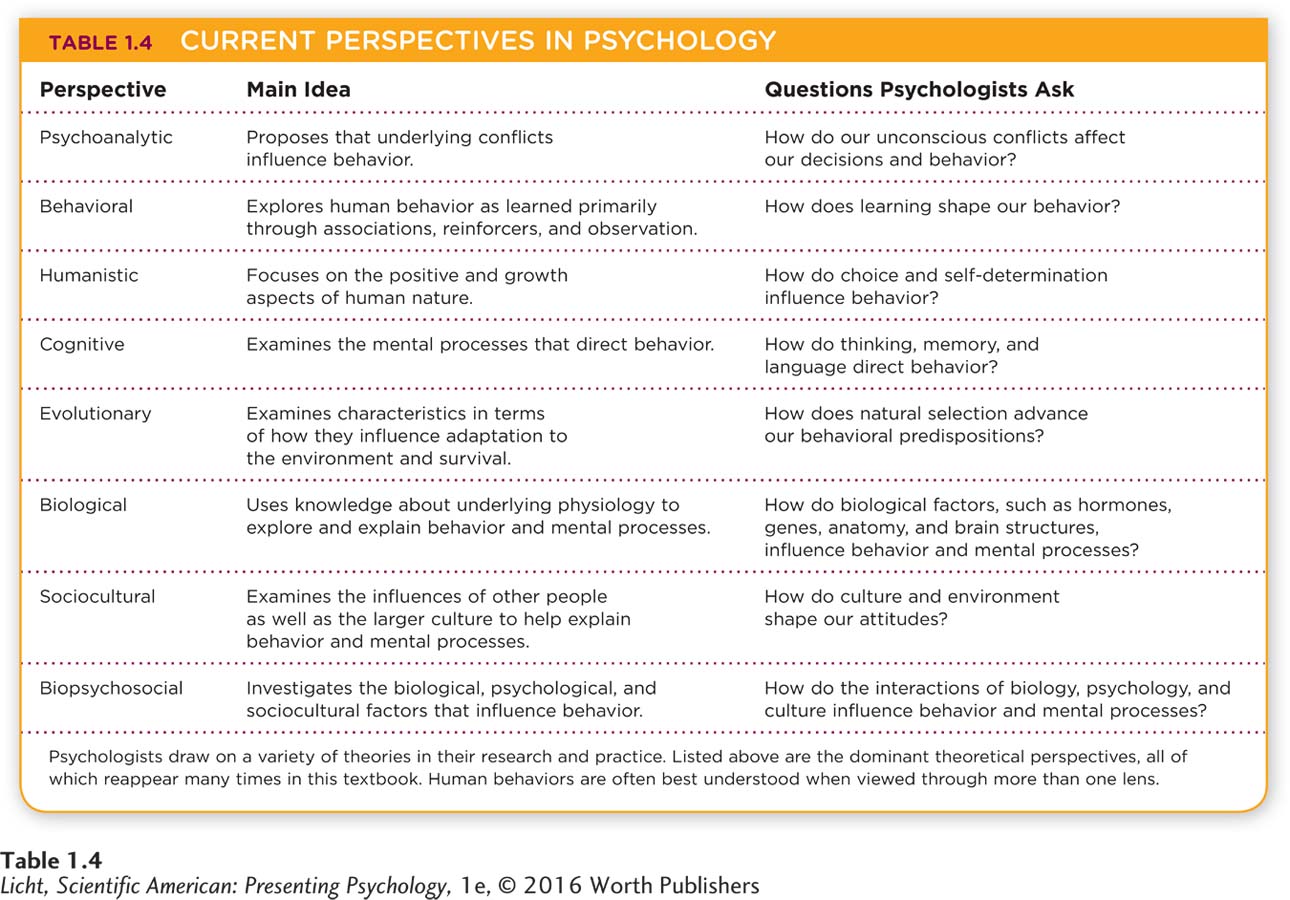
 THE FIRST 17 DAYS Immediately following the mine collapse, the 33 trapped miners switched into survival mode. When faced with a life-
THE FIRST 17 DAYS Immediately following the mine collapse, the 33 trapped miners switched into survival mode. When faced with a life-
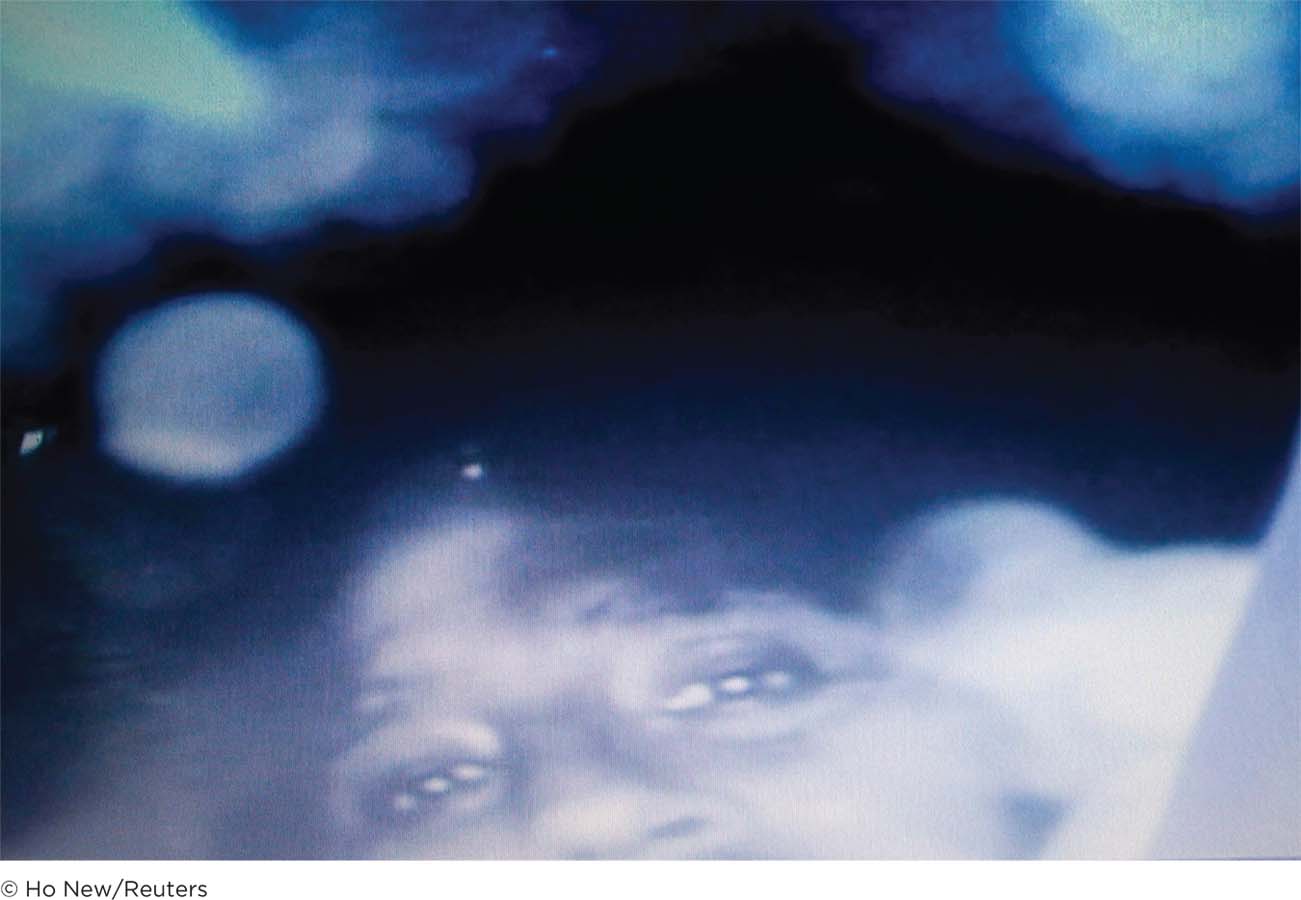
What do you see in the eyes of miner Florencio Ávalos? The image was captured on August 23, 2010, after the miners had endured over 2 weeks of starvation and isolation.
After a sleepless night on the wet floor, the men arose in darkness (morning, noon, and midnight all look the same when you’re half a mile beneath the earth’s surface). But the day started off on a bright note when one of the older miners, José Henríquez, led the group in a prayer. With restored optimism, one group of men began to search the mine’s winding tunnels for escape passages. Another team tried to alert rescue workers by blasting through rock with dynamite sticks, banging the roof with heavy machinery, and beeping the horns of trucks that had been sealed underground with them. Both missions failed, and the miners spent yet another night splayed on jagged slabs of rock (Franklin, 2011).

After 2 weeks of drilling the earth in search of the miners, rescuers finally pierced into a cavern located almost half a mile underground. When the drill bit resurfaced, it carried a bag full of notes, one of which read, “Estamos bien en el refugio los 33” or “We are okay in the shelter, the 33 of us.” The rescuers—
Several days passed without a sign from the world above, and the miners grew weak and weary. To stretch their food supply over several days, they had been forced to limit their intake to one spoonful of tuna fish, half a glass of milk, and one cracker every 24 hours—
By Day 16, each of the miners had lost what appeared to be about 20 pounds (Healy, 2010, August 23). Some had written goodbye letters to their wives and children. “Take care and protect your mother, your sister, you are now the man of the house,” Mario Sepúlveda wrote his teenage son (Franklin, 2011, p. 111). For several days, the men had been hearing the hum of drills, a sure sign that a recovery effort was under way, but no rescue team had actually reached the part of the mine where they were trapped (Franklin, 2011). Then at 5:50 A.M. on the 17th day, a miracle came crashing through the roof of their dank dungeon: the tip of a drill bit. The rescue team had finally found them (Franklin, 2011).
Above ground, rescuers waited anxiously as the drill slowly emerged from underground. The tip of the bit surfaced with orange paint on the bottom and bags of letters—
Now that the miners had a lifeline, a tiny borehole through which food, medicine, and other essentials could be delivered, attention in the media began to shift to their psychological status. Drilling a rescue tunnel wide enough to hoist them out of the mine could take up to 4 months: Were the miners emotionally prepared to wait that long? 
show what you know
Question 1
1. Wilhelm Wundt’s research efforts all involved ____________, which is the examination of one’s own conscious activities.
functionalism
structuralism
reaction time
introspection
d. introspection
Question 2
2. Your psychology instructor is adamant that psychologists should only study observable behaviors. She acknowledges consciousness exists, for example, but insists it cannot be observed or documented, so should not be a topic for psychological research. Which of the following perspectives is she using?
psychoanalytic
behavioral
humanistic
cognitive
b. behavioral
Question 3
3. The process through which inherited traits in a given population either increase in frequency because they are adaptive or decrease in frequency because they are maladaptive is called:
natural selection.
functionalism.
structuralism.
psychology.
a. natural selection
Question 4
4. We have presented eight perspectives in this section. Describe how two of them are similar. Pick two other perspectives and explain how they differ.
Answers will vary. Sociocultural and biopsychosocial perspectives are similar in that both examine how interactions with other people influence behaviors and mental processes. Cognitive and biological perspectives differ in that the cognitive perspective focuses on the thought processes underlying behavior, while the biological perspective emphasizes physiological processes.